| |
A review of hepatitis viral infections in Pakistan
|
| |
| |
Download the PDF here
Download the PDF here
"Pakistan's estimated population in 2011 is over 187 million making it the world's sixth most-populous country, behind Brazil and ahead of Bangladesh. During 1950-2011, Pakistan's urban population expanded over sevenfold, while the total population increased by over fourfold. The population growth rate now stands at 1.6%"
"The HBV prevalence in general population ranged from 1.1-11.9% and the figures for HCV ranged from 2-13.5%"
"Sexual transmission of HCV was checked in few studies to see inter spousal transmission of the disease (Table-15)."
"The prevalence of HCV in Pakistan is 4-6%3 while a community based study in Hafizabad; Punjab revealed the figure to be 6.5%"
"overall data showed that age (OR=1.035, p=0.001), history of blood transfusion (OR=9.204, p=0.004), history of hospitalization (OR=2.979, p=0.043), Tattooing (OR=27.484, p=0.013), family history of hepatitis (OR=4.069, p=0.000), surgical operation (OR=4.290, p=0.030) were found to have significant and positively association with Hepatitis C."
"The mean results of HBsAg and Anti-HCV prevalence on the basis of data aggregated from several studies was calculated which shows 2.3% and 2.5% prevalence of HBsAg and Anti-HCV in children, 2.5% and 5.2% among pregnant women, 2.6% and 5.3% in general population, 3.5% and 3.1% in army recruits, 2.4% and 3.6% in blood donors, 6.0% and 5.4% in health care workers, 13.0% and 10.3% in high risk groups, 12.3% and 12.0% in patients with provisional diagnosis of hepatitis and 25.7% and 54% in patients with chronic liver disease respectively."
"The most common routes of transmission of HCV in developed countries include intravenous drug use, blood transfusions, haemodialysis, needle-stick injuries, tattooing, sexual intercourse and peri-natal infections. In developing countries, therapeutic injections from reused needles and syringes and improper sterilization of invasive medical devices is the major vehicle for transmission of blood borne organisms including hepatitis B virus (HBV), HCV and HIV.7 Overuse and unsafe injection practices cause an estimated 8 to 16 million Hepatitis B virus infections, 2 to 5 million Hepatitis C virus infections and 80,000 to 160,000 HIV infections globally.8 These infections lead to a high burden of chronic disease, disability and death."
Altaf Bosan,Irtaza Ahmad,Rehan Hafiz ( National Institute of Health. )
Huma Qureshi ( Pakistan Medical Research Council. )
Khalif Mohamud Bile ( World Health Organization. )
Jnl of Pakistan Medical Association Dec 2010
Abstract
A review of published literature on viral hepatitis infections in Pakistan is presented. A total of 220 abstracts available in the Pakmedinet and Medline have been searched. All relevant articles were reviewed to determine the prevalence of hepatitis viral infections in Pakistan. Two hundred and three (203) relevant articles/abstracts including twenty nine supporting references are included in this review. Of the articles on prevalence of hepatitis infection, seven were related to Hepatitis A, fifteen to Hepatitis E while the remaining articles were on frequency of hepatitis B and C in different disease and healthy population groups. These included eight studies on healthy children, three on vertical transmission, nineteen on pregnant women, fifteen on healthy individuals, six on army recruits, thirty one on blood donors, thirteen on health care workers, five on unsafe injections, seventeen on high risk groups, five on patients with provisional diagnosis of hepatitis, thirty three on patients with chronic liver disease, four on genotypes of HBV and five on genotypes of HCV. This review highlights the lack of community-based epidemiological work as the number of subjects studied were predominantly patients, high risk groups and healthy blood donors.
High level of Hepatitis A seroconversion was found in children and this viral infection accounts for almost 50%-60% of all cases of acute viral hepatitis in children in Pakistan. Hepatitis E is endemic in the country affecting mostly the adult population and epidemic situations have been reported from many parts of the country.
The mean results of HBsAg and Anti-HCV prevalence on the basis of data aggregated from several studies was calculated which shows 2.3% and 2.5% prevalence of HBsAg and Anti-HCV in children, 2.5% and 5.2% among pregnant women, 2.6% and 5.3% in general population, 3.5% and 3.1% in army recruits, 2.4% and 3.6% in blood donors, 6.0% and 5.4% in health care workers, 13.0% and 10.3% in high risk groups, 12.3% and 12.0% in patients with provisional diagnosis of hepatitis and 25.7% and 54% in patients with chronic liver disease respectively.
This review has illustrated the high endemicity of hepatitis viral infections in Pakistan where hepatitis B and C potentially account for a serious burden of the disease. This review has triggered the launching of a network intervention for the control of hepatitis viral infectious.
This review was used as the basis for the launch of hepatitis programme, but putting it into a formal review took time and the hepatitis program was initiated.
Correspondence: WHO Country Representative, World Health Organization, NIH premises, Chack Shahzad, Islamabad.
Introduction
Viral hepatitis is a serious global public health problem. At present, six distinct types of hepatitis virus have been identified and called as hepatitis A, B, C, D, E and G viruses. For Hepatitis A virus (HAV) and Hepatitis E virus (HEV), the primary source of infection is the faeces with fecal-oral route being the most predominant mode of transmission. Hepatitis B virus (HBV), Hepatitis C virus (HCV), and Hepatitis D virus (HDV) are blood borne viruses and are primarily transmitted through a breach in the skin (percutaneous) or mucosa (mucosal). All hepatitis viral infections are acute but hepatitis B, C and Delta can also result in chronic infections.
Acute viral Hepatitis A is a common infection among children in Pakistan and accounts for 50-60% of all cases of acute viral hepatitis in children. Almost 96% of the population is exposed to HAV by the age of 5 years and 98-100% at adulthood.1-3
Size and this is a review and what ever published data is available is compiled here so the question of small sample does not arise. The method of diagnosis, sample site of data is given in the tables.
Hepatitis E is a disease of mild to moderate severity (mortality rate of 0.4 - 4.0%) except in pregnancy, where the mortality rate may reach 20% in last trimester of pregnancy especially during epidemics.4 HEV is a major cause of acute viral hepatitis (AVH) in Pakistan particularly in adults from lower socioeconomic groups. Hepatitis E virus typically spreads by faecal contamination of water. The infection is endemic in developing countries and turns into mini epidemics in grave situations. Hepatitis E is endemic in Pakistan5 and occurs mostly during summers, rains and floods. Major epidemic outbreaks occur in areas where drinking water gets contaminated with sewage and where people have a communal living and drinking water from a common contaminated source.
Hepatitis B (HBV) and C (HCV) viral infections are transmitted through blood and body secretions which penetrate the human body through a breach in the skin, mucosa or vein. Both the viruses cause acute hepatitis which clears within 6 months in 80% cases of HBV and 20% cases of HCV. In 20% HBV and 80% HCV cases the virus becomes chronic and may progress to chronic liver disease.
The consequences of HBV infection depend on the age of its acquisition. There is an over 90% risk of a new born to get infected and become a long term carrier of HBV. This risk drops from about 90% in the first six months of life, to about 25% by the age of five years, and to 10% by the age of 15 years. It is unusual (2%- 5%) for adults who are infected later in life to become chronic carriers.6
The most common routes of transmission of HCV in developed countries include intravenous drug use, blood transfusions, haemodialysis, needle-stick injuries, tattooing, sexual intercourse and peri-natal infections. In developing countries, therapeutic injections from reused needles and syringes and improper sterilization of invasive medical devices is the major vehicle for transmission of blood borne organisms including hepatitis B virus (HBV), HCV and HIV.7 Overuse and unsafe injection practices cause an estimated 8 to 16 million Hepatitis B virus infections, 2 to 5 million Hepatitis C virus infections and 80,000 to 160,000 HIV infections globally.8 These infections lead to a high burden of chronic disease, disability and death.
This review shall serve as a valuable technical resource article for policy makers, planners and health professionals with the objective to generate sufficient evidence for policy and programmatic action. The analysis of the currently available literature will also help in reorganizing the endemicity level of these hepatitis viral infections and thus enable future national control interventions.
Methods
Pakmedinet and MEDLINE search was undertaken using the key words "Hepatitis, Hepatitis A, B, C, D and E prevalence, epidemiology, transmission, and carrier". All studies pertaining to prevalence of infections conducted in Pakistan were included in this review. A manual search was also carried out on many indexed Pakistani journals. In most instances full articles were reviewed but in cases where full article could not be traced, the abstract was used. The 95% confidence intervals for the prevalence studies were calculated by using the prevalence reported and the sample size of the study.
All studies where less sensitive methods like CIEP or chromatography was used for testing were excluded from the analysis and only studies using assays like ELISA, EIA, MEIA were included, as these assays are more sensitive and specific.
Results
A total of 220 abstracts were reviewed and of these only 208 articles were finally included in this review to determine the prevalence of hepatitis A to E viral infections in Pakistan.
Very few community based studies on the prevalence of Hepatitis viral infections are available in Pakistan. However, most published studies are hospital or clinics based and therefore show a variation in the reported frequencies/prevalence. Overall, the data suggests that these infections are endemic in Pakistan. The reported prevalence figures in the general population, blood donors and among pregnant women have placed Pakistan among the countries with intermediate endemicity.
The results of the meta analysis of the present review have been tabulated separately for waterborne infections and blood borne infections and the group-wise results are given below:
Hepatitis A and E
Hepatitis A infection:
Almost all studies on hepatitis A showed high prevalence of Hepatitis A (HAV) infection in children especially those who were admitted in hospitals with acute hepatitis. Most of the children were exposed to the virus during early life and remain immune for life as seen by the presence of IgG antibodies in adults in these studies (Table-1).

Hepatitis E infection:
Most studies on hepatitis E infection (Table-2)
were a part of the clinical work of acute hepatitis in patients who were admitted with jaundice. Four studies have reported mini epidemic outbreaks due to faecal contamination of water. Total HEV was checked in most studies while in few HEV IgM antibodies which are specific of acute infection were tested. Two studies on pregnant cases with jaundice showed HEV positivity of 57-61% while a 3rd study in non pregnant females showed mortality in 33% of the cases who went into fulminant hepatic failure.

Hepatitis B and C:
Hepatitis B and C infections cause significant morbidity and mortality in Pakistan. Many studies have been reported from medical screening camps, hospitals and clinics in different groups of individuals to see the magnitude of the problem. Prevalence of HBV and HCV infection in various groups is presented below:
Children:
Studies on HBs Ag and Anti-HCV in healthy children showed a prevalence of HBs Ag between 1.9%-3.6% and for Anti-HCV between 0.4%-4% (Table-3).

Mother to infant transmission:
The contribution of perinatal transmission to the overall burden of disease is related to the prevalence of HBe Ag in the pregnant woman. If a mother is HBs Ag positive and HBe Ag positive there is over 90% chance that she will transmit the infection to her infants.1
Maternal to child transmission of HBsAg and HBeAg was done in 3 studies. Kazmi etal35 screened 6225 mothers and found 249 HBs Ag positive. Out of 249 HBs Ag positive mothers 55 were HBeAg positive. In another study 50 infants born to HBsAg and HBeAg positive mothers were followed. The cord blood of these newborns was tested for HBeAg and the infants were followed for 18 months for the status of HBsAg. About 90% of HBeAg positive mothers transmitted HBV to their infants.
Aisha et al36 conducted a study in 245 pregnant women and found 8 cases positive for HBs Ag, of whom one was positive for HBe Ag. Eight babies born to sero-positive mothers were tested for HBs Ag and HBe Ag and all were found negative for these markers.
Iqbal33 screened 417 mothers and 538 children separately for HBs Ag and found 2.3% positive mothers and 3.3% positive children. Of these one mother and two children were HBe Ag positive.
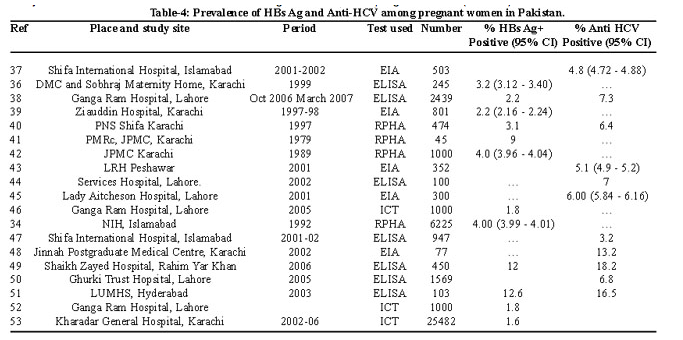
Pregnant women:
Many studies are available on the status of HBs Ag and anti HCV in pregnant cases (Table-4).
HBs Ag was generally reported with low frequency in private sector patients39,41 and high in public sector patients.
General population:
Although there are no population studies on the prevalence of HBV and HCV infections in the country but the summation of available data on various healthy groups like voluntary blood donors, pregnant women, recruits and healthy individuals provide the infection status in the country (Tables-5,6,7).
The HBV prevalence in general population ranged from 1.1-11.9% and the figures for HCV ranged from 2-13.5%
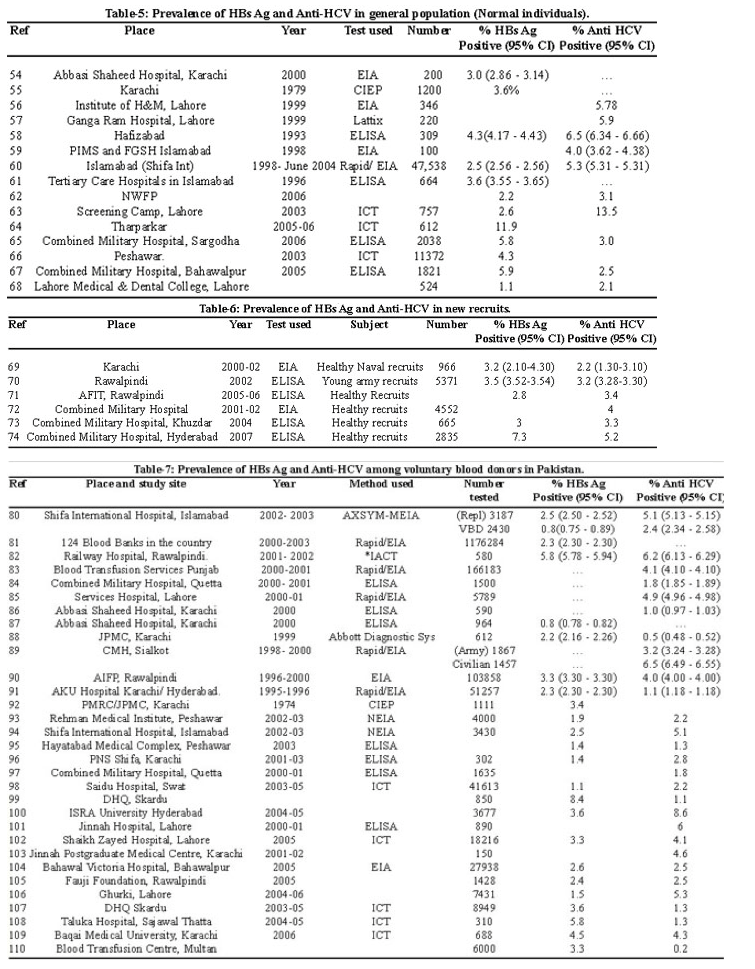
Special groups:
Recruits:
The healthy individuals who were screened prior to their induction in the armed forces showed HBsAg range from 3- 7.3% and HCV from 2.2- 5.2% (Table-7).
Blood donors:
75 and 76 new references to be added. In Pakistan over 1.5 million pints of blood are collected each year.77 The main source of blood (65%) was replacement donors78 with another 10% from professional/paid donors. Only 25% donations came from volunteer non-remunerated blood donors.79 Most of the replacement donors are patient's relatives or friends.
The blood screening data showed higher prevalence of Anti-HCV as compared to HBs Ag in all years.
High risk groups:
Significant HBV and HCV transmission occurs in selected high risk groups including health care workers, injecting drug users and patients receiving blood products.
Table-8 shows the data of 13 studies in health care workers. The prevalence of HBsAg in this group ranged from 2.4-20%. Highest prevalence was seen in dentists (17%) and sweepers (20%). The anti-HCV prevalence ranged from4-10% with highest positivity of HCV (10%) in health care workers who reported needle stick injuries while working.
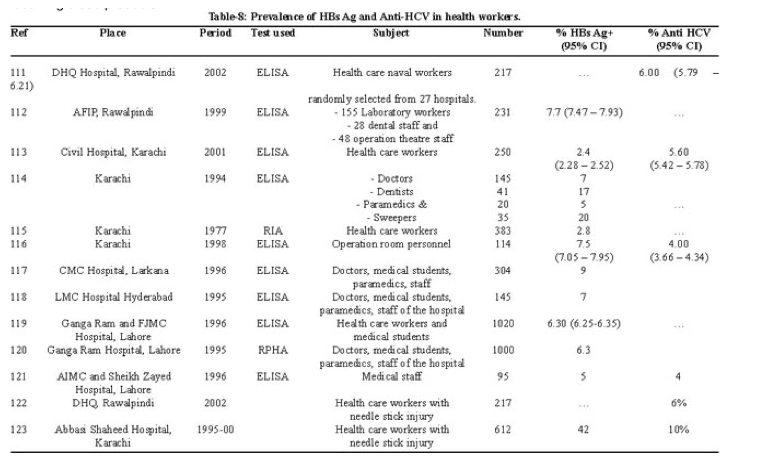
Trend of HBV & HCV infection in a community as per the use of injections:
Few studies have been published in Pakistan where the risk of unsafe injections for transmission of Hepatitis B and C infections has been highlighted (Table-9).
In a cross sectional study Khan et al124 identified injections as the major risk factor for Hepatitis C infection in patients seeking health care in a peri-urban community in Karachi. Luby125 found 16% HCV infection among households of HCV infected patients in Hafizabad. Khan et al126 studied the risk factors for the transmission of HBV or HCV in patients with chronic liver disease and found therapeutic injections, surgery, blood transfusion and dental extraction as the major risk factors for both these diseases.

Trend of HBV & HCV infection in other high risk groups:
Many studies have been done on the high risk groups like injecting drug users, commercial sex workers, transvestites and patients receiving blood products. All these studies also revealed high prevalence of HBs Ag and Anti-HCV in these groups. HBs Ag infection was found in 12% of the commercial sex workers (women) in Lahore while it was only 3.4% among transvestites in Karachi who acknowledged commercial sex with men. The mean prevalence of HBV and HCV in these groups was 15.5% and 12.3% respectively (Table-10).
The prevalence of these infections in individuals receiving multiple blood transfusions was high. For thalaessemia, the HBV figures ranged between 7.5-8.4% while for HCV they were between 36-56%. Figures in haemophilia were similarly high. In dialysis population HBV figures were 12.4% and HCV 20%.
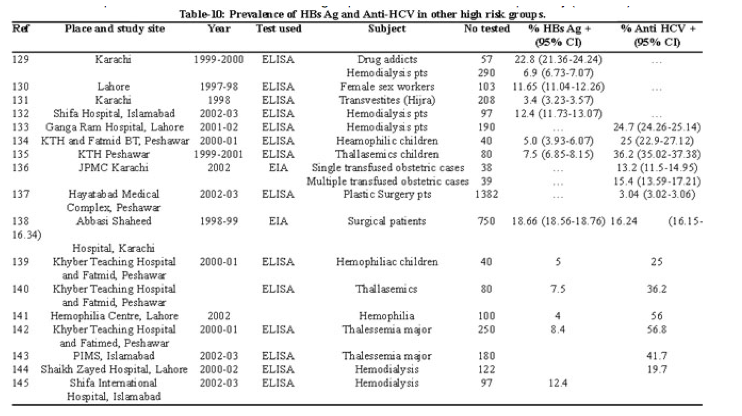
Patients with provisional diagnosis of hepatitis:
Studies in patients who were admitted with a provisional diagnosis of hepatitis (Table-11)
showed a prevalence of HBs Ag ranging between 10% - 45% while only one study showed 12% HCV infection.

Chronic liver disease patients:
Many studies are reported on HBV/ HCV positivity in chronic liver disease cases (Table-12).
The HBsAg positivity in patients with chronic liver disease ranged from 10-46.6% and for HCV from 40-86% which is more than twice of that seen with HBV. Two studies are available in children and both show high prevalence of HBV but low of HCV.
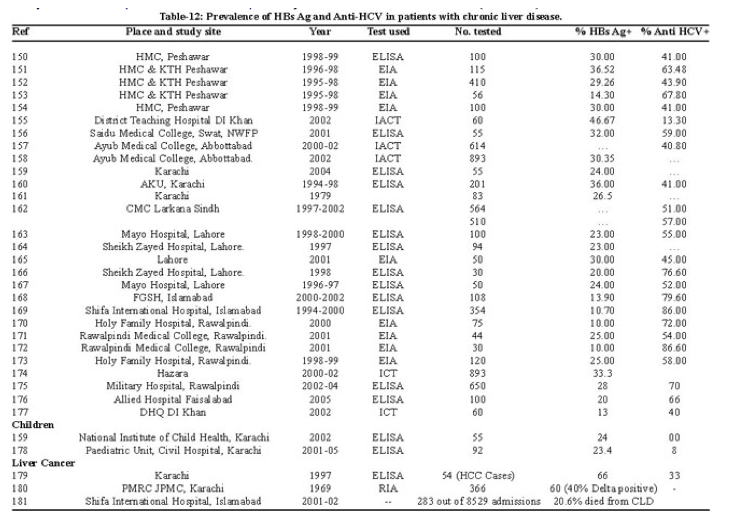
Genotypes and serotypes of HBV and HCV:
Variable results are seen on genotypes of HBV (Table-13).
Majority of the studies from Sindh showed a high prevalence of genotype D while a study from Punjab showed high C.
Many studies on HCV serotypes have been carried out (Table-14)
and all showed that in over 80% the cases, genotype 3 was detected, followed by genotype 1, 2 and 4. Genotypes are important to determine the treatment response and disease transmission epidemiology. Better response to interferon and short term treatment (6 months) is reported in hepatitis C patients infected with serotype 3 while for all other genotypes a longer duration of therapy is suggested.
Sexual transmission of HCV was checked in few studies to see inter spousal transmission of the disease (Table-15).
Studies from Sindh192,195 show a higher frequency of disease in the spouses while those from Punjab show a low frequency.191,193,194
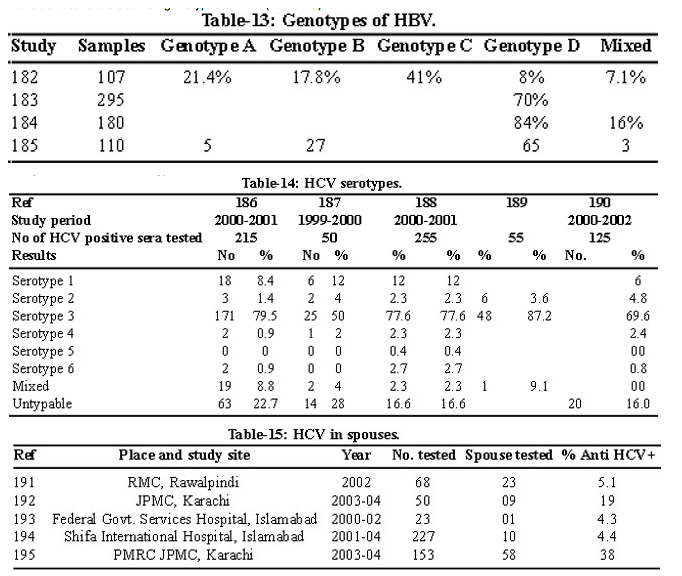
Hepatitis Delta (HDV):
Delta virus is dependant on presence of HBsAg for its transmission and survival. It can infect as co infection where both viruses are transmitted at the same time resulting in high mortality because of fulminant hepatitis. Super infection occurs in an already known HBV carrier who is exposed to delta virus, thus resulting in chronic liver disease. Zuberi196 reported 408 cases of chronic liver disease due to HBV infection of which 44% had delta super infection and 1.4% co infection. Riaz et al197 from Karachi studied 531 cases of HDV at a hepatology unit of a public sector hospital using EIA. Majority of their cases (68%) came from Northern Sindh, followed by Balochistan (17%) and death in most of these cases was due to complications of liver disease and failure. Mumtaz et al198 studied 8721 patients with chronic HBV disease and found HDV antibody in 1444(16.6%) cases and HDV infected cases has milder liver disease when compared with non delta infected HBV cases.
Discussion
Pakistan has a high disease burden of hepatitis A to E, with maximum morbidity in hepatitis A and E and maximum mortality in hepatitis B, C and D. The aim of this review was to determine the extent of hepatitis problem in the country and to provide road map for the policy makers in the development of national strategy on the prevention and control of hepatitis. This review provides sufficient evidence of infection in different groups.
Hepatitis A accounts for 50-60% of all cases of acute viral hepatitis in children. This infection is uncommon in adults but those who get infected have a longer convalescence and prolonged morbidity. Most of the children are exposed to this virus during their early age and remain immune for rest of their life. Vaccine is available for its prevention but its use is recommended for travelers coming from low endemicity areas and during epidemics and natural disasters.199 Two doses of hepatitis A vaccine are recommended which produce life long immunity
In Pakistan, Hepatitis E mainly affects the adult population. A number of mini epidemics have been reported in the country. Once infected recovery is a rule except in late trimester of pregnancy where a 30% maternal or foetal loss is reported especially during epidemics.200 Hepatitis E like hepatitis A infection is endemic in Pakistan due to faecal contamination of drinking water. In urban areas, the main water supply line gets contaminated from the nearby leaking sewage pipe while in rural areas water from wells, streams, canals, rivers and ponds gets contaminated by direct disposal of sewage in these sites. The immunity of hepatitis E lasts for 8-10 years and is lost thereafter making the individual susceptible to re-infection. A vaccine trial was done in Nepal with good results,201 but no vaccine is commercially available, therefore prevention of hepatitis E infection needs to be propagated.
Hepatitis B and C infections are blood borne and are transmitted through unscreened blood transfusions, inadequately sterilized invasive medical devices and re use of syringes.
Using WHO's criteria of endemicity of hepatitis B virus countries with a carrier rate of less than 3% fall in the low endemic region, those with rates between 3-5% fall in intermediate and those above 5% in high endemic region.202 The previous review showed that the prevalence of hepatitis B in Pakistan is around 4% in general population.196 With a sizable pool of delta positive cases in some parts of Sindh Punjab and Baluchistan,196-98 and a low EPI coverage of hepatitis B vaccine in some districts203 there is a high chance that this viral infection will continue to cause a major disease burden in our country. To contain the disease strategies have to be laid down to improve immunization coverage. Studies on vertical transmission of HBeAg are scarce; and some published studies are not so much supportive to decide for introducing the birth dose hepatitis B vaccine. There is need to study the HBsAg status in vaccinated children and see if vaccination at 6 weeks should be continued or an extra dose should be given at day zero.
For HCV, the global figures are that about 3% of the world's population is suffering from this viral infection. In Pakistan the prevalence of HCV infection is around 5%.196 Pakistan has the highest rate of therapeutic intramuscular injections per person per year.124,127,128 Apart from the known risk factors of blood transfusion, reuse of syringes and improper sterilization of invasive medical devices; shaving by barbers is coming up as another source of spread of this disease. As no vaccine is available for its prevention therefore adherence to best clinical practices and standard operating procedures for sterilization and disposal of hospital waste must be practiced along with legislation against non compliant blood banks and hospitals.
Clinical significance of HBV and HCV serotypes is important to see the disease response to treatment and progression. Of the HBV serotypes, type A and D are associated with cirrhosis of the liver and type C with liver cancer. Studies from Sindh show higher frequency of genotype D,183-85 while those from Punjab show more HBV genotype C182 which is associated with the development of cirrhosis and HCC as well as lower response rate to interferon or nucleoside analogue therapy as compared to genotype B.182
In hepatitis C six serotypes have been identified.1-6 Global studies have shown that serotype 3 is most easy to treat with a cure rate of around 80 percent.204 In Pakistan serotype 3 is most common. Most studies show about 50-70% sustained viral response with interferon therapy for 6 months.205-207
There is no national data on the leading causes of admissions to hospitals in Pakistan and the contribution of liver disease to overall mortality. One study from Peshawar showed 23% of total admissions of gastroenterology in a year were made for liver diseases.208 Khokhar et al181 reviewed twelve months admission data to see the cause of deaths in 283 cases out of 8529 admissions. There were 160 deaths related to medical causes, including 33 (20.6%) deaths from chronic liver disease.
Keeping in view the high disease burden of viral hepatitis infections and severity of its complications from hepatitis to cirrhosis and cancer, the Prime Minister of Pakistan launched a hepatitis prevention and control programme in collaboration with the ministry of health, the provincial health departments, to reduce the disease prevalence and incidence.
|
|
| |
| |
|
|
|